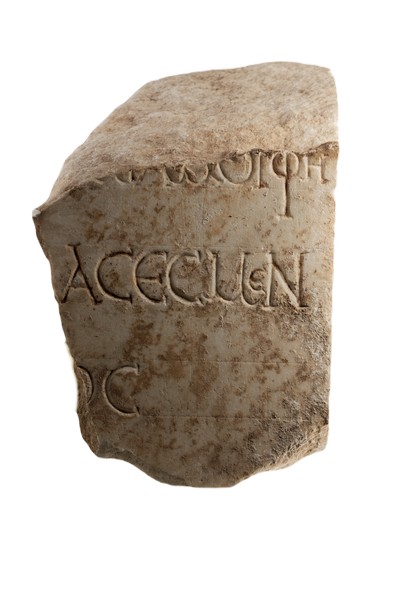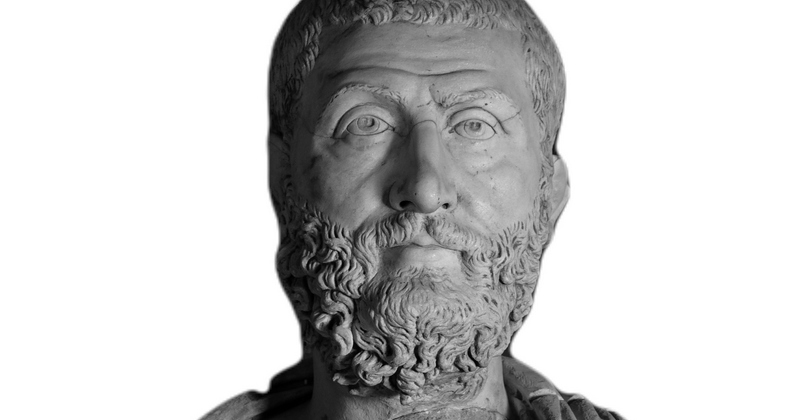Among the impressive and at the same time enigmatic finds unearthed during the excavation of the Great Baths of Dion and the adjacent area is a portrait herm of white fine-grained marble [Fig. 1]. The torso, broken into seven pieces, was found in the northeastern hall of the building, while the head down to the point of the neck in a workshop in the villa of Dionysus.
The upper part of the stele is in the form of a bust with a rudimentary suggestion of the sternum.The portrait depicts a man of mature age with short hair and a thick beard. The male genitals are clearly represented at their base. On the lateral sides of the torso, just below the shoulders of the bust, there are two rectangular deepenings that received ‘elbows’. The folds of a himation are rendered on the shoulders and on the left side of the chest. On the upper part of the stele the following four-line inscription is engraved:
Εἷς τύπος ἐν δοιοῖσι
κα̣[ὶ ἀ]μ̣φοτέροις μία μορφ[ή]·
οἱ δύο δ’ ὡς ὁρᾷ[ς] ἐ̣σ̣μὲν
Ἑρεννιανός
Transl.: “One figure in two, and for both one form. And we are both, as you can see, Herennianus”.
Based on the typological features of the portrait, the monument can be dated to the middle to late Severan period, a dating that is also supported by the ductus and lettering of the inscription. The epigram is composed in elegiac couplets. As the phrase ὡς ὁρᾶς (“as you see”) indicates, the herm belongs to the so-called ‘speaking’ monuments, in which the depicted person addresses the passerby and introduces himself. The narrative follows a circular composition (εἷς τύπος > μία μορφή > Ἑρεννιανός), and explains with a play of numbers that one form (i.e., the portrait) appears in two (i.e. copies) that have the same shape (i.e., the herm) and that both represent Herennianus.
The information contained in the text that the monument is ‘twin’ with another one was confirmed by a later excavation in the area, which uncovered the left part of a Hermaic stele bearing a (partially preserved) inscription identical to that on the first stele [Fig. 2]. The presence of double or even multiple sculptural representations – including herms – found in the same city or even in the same place was a common practice since the Hellenistic period and is documented both epigraphically and archaeologically.

Indeed, the wordplay of the epigrammatist of Herennianus’ herms is based on the direct visual contact that the passerby has with them and presupposes that the two similar monuments were erected in the same place and in immediate proximity to each other so that the viewer, through direct visual contact with them, could ‘play’ with the images.
We have no further information on Herennianus. The location of his two monuments, i.e. in one of the busiest public places in the city, but also the content of the inscription itself, show that they possibly had an honorary character. In this context, the honorand is a member of the city’s elite and probably a civic benefactor. It cannot be excluded that his beneficial action towards his homeland is connected with the baths. The erection of two similar honorary monuments and their arrangement in the same place can be interpreted as a tangible proof of the recognition of his benefaction by his fellow citizens and certainly increased the honor paid to him.
Bibliography: M. Iatrou, «Hermaic Stele with a Portrait of Herennianus», in: D. Pandemalis (ed.), Gods and Mortals at Olympus. Ancient Dion, City of Zeus, New York 2016, 124-125 αρ. 43.
D. Pandemalis, Δίον. Η ανακάλυψη, Athens 1999, 157-159.


